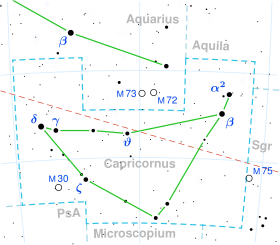| Observation data Epoch J2000.0 Equinox J2000.0 (ICRS) | |
|---|---|
| Constellation | Capricornus |
| Right ascension | 20h 51m 49.29095s[1] |
| Declination | −26° 55′ 08.8912″[1] |
| Apparent magnitude (V) | +4.11[2] |
| Characteristics | |
| Spectral type | K4 III[3] |
| U−B color index | +1.93[2] |
| B−V color index | +1.64[2] |
| Variable type | Suspected[4] |
| Astrometry | |
| Radial velocity (Rv) | +9.1±1.4[5] km/s |
| Proper motion (μ) | RA: −9.261[1] mas/yr Dec.: −1.598[1] mas/yr |
| Parallax (π) | 3.1381 ± 0.3711 mas[1] |
| Distance | approx. 1,000 ly (approx. 320 pc) |
| Absolute magnitude (MV) | −2.7[6] |
| Details | |
| Mass | 6.8±0.9[7] M☉ |
| Radius | 172.1+6.1 −12.0[1] R☉ |
| Luminosity | 6,269+826 −833[1] L☉ |
| Surface gravity (log g) | 0.85[8] cgs |
| Temperature | 3,915+138 −68[1] K |
| Metallicity [Fe/H] | −0.24[9] dex |
| Rotational velocity (v sin i) | 4.68[8] km/s |
| Age | 48.1±8.3[7] Myr |
| Other designations | |
| Database references | |
| SIMBAD | data |
Omega Capricorni, which is Latinized from ω Capricorni, is a star in the southern constellation Capricornus, near the southern constellation border with Microscopium. It is an orange hued star that is faintly visible to the naked eye, having an apparent visual magnitude of +4.11.[2] Based upon an annual parallax shift of 3.1 mas as seen from the Earth,[1] it is located approximately 1,000 light years from the Sun. It is a candidate member of the Ursa Major Moving Group[11] and has a relatively high peculiar velocity of 25.7±1.9 km/s, making it is a possible runaway star.[7]
In Chinese, 天田 (Tiān Tián), meaning Celestial Farmland, refers to an asterism consisting of ω Capricorni, 3 Piscis Austrini, 24 Capricorni and ψ Capricorni.[12] Consequently, the Chinese name for ω Capricorni itself is 天田二 (Tiān Tián èr, English: the First Star of Celestial Farmland.)[13]
This is an evolved K-type giant star with a stellar classification of K4 III,[3] and is a suspected variable.[4] With the supply of hydrogen at its core exhausted, the star has expanded to about 172[1] times the radius of the Sun. It is 48[7] million years old with 7 times the mass of the Sun.[7] Omega Capricorni is radiating 6,300[1] times the luminosity of the Sun from its bloated photosphere at an effective temperature of 3,915 K.[1] It is a barium star,[6] showing an overabundance of the s-process elements. This suggests that Omega Capricorni has an orbiting white dwarf companion.[14]
- ^ a b c d e f g h i j k l Cite error: The named reference
GaiaDR2was invoked but never defined (see the help page). - ^ a b c d Cite error: The named reference
Nicolet1978was invoked but never defined (see the help page). - ^ a b Cite error: The named reference
houk1979was invoked but never defined (see the help page). - ^ a b Cite error: The named reference
AAVSOwas invoked but never defined (see the help page). - ^ Cite error: The named reference
Gontcharov2006was invoked but never defined (see the help page). - ^ a b Cite error: The named reference
Mennessier1997was invoked but never defined (see the help page). - ^ a b c d e Cite error: The named reference
Tetzlaff2011was invoked but never defined (see the help page). - ^ a b Cite error: The named reference
Hekker2007was invoked but never defined (see the help page). - ^ Cite error: The named reference
McWilliam1990was invoked but never defined (see the help page). - ^ Cite error: The named reference
SIMBADwas invoked but never defined (see the help page). - ^ Cite error: The named reference
Chupina2006was invoked but never defined (see the help page). - ^ (in Chinese) 中國星座神話, written by 陳久金. Published by 台灣書房出版有限公司, 2005, ISBN 978-986-7332-25-7.
- ^ (in Chinese) AEEA (Activities of Exhibition and Education in Astronomy) 天文教育資訊網 2006 年 7 月 3 日 Archived 2011-05-21 at the Wayback Machine
- ^ Cite error: The named reference
gomez1997was invoked but never defined (see the help page).
